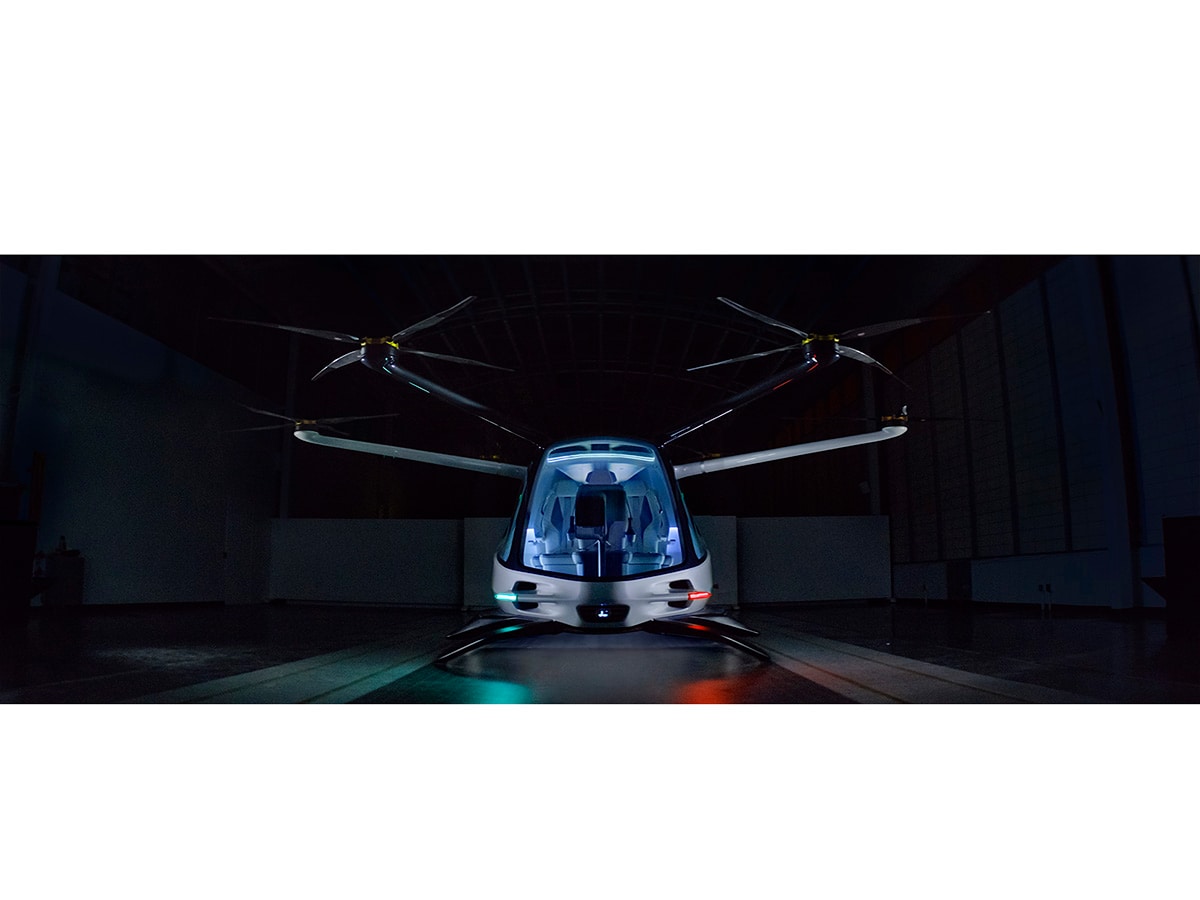- Skai is an air mobility vehicle co-designed by BMW Designworks
- Powered by hydrogen fuel cells with zero emissions
- Six electric motors operate six rotors
- Up to 400-mile range
- Four-to-five passenger capacity in a luxuriously designed cabin
- Piloted version launches first, with autonomous versions to follow
- Safety features include a parachute for the entire vehicle
“How do you get rid of gridlock?” Good question to ask in a corporate office park about 30 miles north of Los Angeles, home of the worst traffic in the world according to USA Today. Dr. Bruce J. Holmes, Director of Alaka’i Technologies, has an option. Skai, a personalized air vehicle that can take off and land anywhere.
Alaka’i, partnering with BMW Designworks, takes a jump into air mobility with a vehicle that might be the coolest minivan you’ve never seen. With a team that’s a who’s who of the aerospace world, the Skai vehicle has been designed and backed by engineers and pilots from NASA, Raytheon, Beech, Cirrus, the Department of Defense and Dayjet. Sounds like the greatest nerd convention on steroids.
Operated by hydrogen fuel cells, Skai uses six motors for its six independent rotors, eschewing the traditional single- or double-rotor helicopter design. Those rotors, positioned away from the passenger cabin, minimize impact on the cabin, reduce noise and vibration, and enhance safety. Should one or two of the rotors fail in flight, Skai can still land safely. More than just blind spot warnings, Skai also comes equipped with a parachute for the entire vehicle.
The reason behind using hydrogen to power Skai was twofold. Currently, it’s the cleanest way to power a vehicle with the lowest environmental impact. Fuel cells are 95 percent reusable and 99 percent recyclable. Second, high performance is a must in this airborne mobility application. As with any aircraft the main needs to address are thrust, lift and drag, while accommodating speed, range and payload. Hydrogen cells have 10 times the capacity of lithium ion batteries, meaning you can carry more payload for a longer period of time.
Skai designers are aiming high when it comes to performance numbers. Ultimate estimate goals are up to four hours of flight time with a 400-mile range. That includes accommodating up to five passengers and a payload capacity up to 1,000 pounds. With this kind of brain trust behind them, we’d put our money on those benchmarks being realized. For now, they could tell you how they’ll do it, but then they’d have to kill you.
“It’s about simplicity. That concept works when it comes to cost, operation, and acquisition, and that was the aim with Skai.” Steve Hanvey, CEO Alaka’i Technologies, a former Marine test pilot who flew Apache helicopters in Vietnam. While pricing for Skai isn’t available, we were told something akin to a luxury vehicle was a good starting reference point. Hanvey used Ferrari as an entry point, so get your family and friends together, because there are lots of zeros on the price tag for even the prancing horses’ least-expensive Portofino.
Ask anyone who works on vintage Lamborghinis, when it comes to motors simplicity sounds awfully nice. In an aircraft it makes even more sense as it reduces cost with fewer parts, there’s a simpler path to certification and weight is reduced. Better safety, greater durability and reliability and ease of use — yes, these are all things we’d want in sky full of Skais.
There are infrastructure hurdles such as airspace management, but it wasn’t that long ago when the Model T bumped down roads where traffic lights didn’t exist. This future is not too far away, and there’s a growing ecosystem that’s willing to support it. If you’ve spent any time crawling over the Sepulveda Pass that connects the Westside of Los Angeles to the San Fernando Valley, you’d support personalized air mobility, too.
The Skai’s interior design leans toward a minimalistic approach, but utilizes luxury fit and finish familiar to the high-end car market. With its leather seats, ambient LED lighting, an Alcantara headliner, 360-degree views from each seat with generous leg- and headroom, Skai’s interior looks like it’s fresh out of an auto show concept car confidently rotating on a dais.
The exterior is made of composite materials adding to its lightness. A three-dimensional front window and roof affords a panoramic view while a glass sliding door offers passengers easy entry and exit, see, best minivan ever. The Skai rests on skids for easy landing.
Skai is still under development and awaits FAA certification, but in the meantime the folks over at Alaka’i Technologies and BMW Designworks have given us another reason to believe our childhood Jetsons dreams just might come true in our lifetime.












